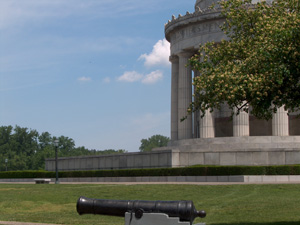The political history of Indiana is a rich one. From before the creation of the Northwest Territory until the drafting of the first constitution, Indiana felt many of the political pressures and conflicts that would erupt on a national scale.
 I researched my project with various secondary sources and by thumbing through plenty of fragile, primary documents in several libraries and archives. I also visited Corydon and Vincennes to see the monuments and historical sites of these two capitals as well as take in the atmosphere and scenery. Indiana's road to statehood is an essential piece to the founding of an American union.
I researched my project with various secondary sources and by thumbing through plenty of fragile, primary documents in several libraries and archives. I also visited Corydon and Vincennes to see the monuments and historical sites of these two capitals as well as take in the atmosphere and scenery. Indiana's road to statehood is an essential piece to the founding of an American union.
The Northwest Ordinance of 1787 provided insight into the pre-constitutional federal government and anticipated many of the problems and successes of the U.S. constitution.
Territorial governor, William Henry Harrison attempted to circumvent the Northwest Ordinance's ban on slavery and the influence of his office could be recognized far beyond Indiana's boundaries. The building in which the territorial legislature was housed was referred to as "Veto Hall," due to Harrison's active participation, no doubt.
The Suffrage Acts of 1808 and 1809 stand as victories for the extension of voting rights, the citizens of Indiana Territory petitioned Congress and their voices were heard.
 The delegates of Indiana's 1816 constitutional convention regularly worked under the shade of a large elm tree on the property of a nearby resident in Corydon. The Constitution Elm, as it was later known, became a symbol of Indiana's statehood and was immortalized with a monument in 1936, years after its death of Spanish Elm disease.
The delegates of Indiana's 1816 constitutional convention regularly worked under the shade of a large elm tree on the property of a nearby resident in Corydon. The Constitution Elm, as it was later known, became a symbol of Indiana's statehood and was immortalized with a monument in 1936, years after its death of Spanish Elm disease.